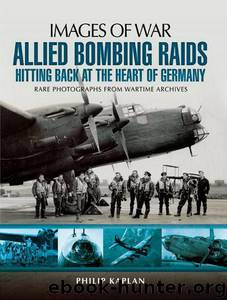Allied Bombing Raids: Hittiing Back at the Heart of Germany: Rare Photographs from Wartime Archives (Images of War) by Kaplan Philip

Author:Kaplan, Philip [Kaplan, Philip]
Language: eng
Format: azw3
Tags: HISTORY / Military / Aviation
ISBN: 9781473834590
Publisher: Pen and Sword
Published: 2014-02-18T16:00:00+00:00
At the end of a raid, a belt of whisky and a quick bite usually awaited the returning fliers, along with an interrogation on their recent experience.
Armorers bringing the bombs to the aircraft.
An 8AF armorer checking the fuse of a bomb.
The officers’ club lounge on an 8AF base in England.
Always, following a mission, there would be lots of questions in the operations block—interrogation, or debriefing, as it was later called. The airmen would be given something to relax them: cigarettes on the table, cocoa and a tot of rum for the RAF, coffee and perhaps a slug of scotch or brandy for the USAAF. The men who didn’t care for alcohol would sometimes pass their ration to the ones who did. The crews, often weary and not always quite coherent, were questioned by officers of the Int/Ops branch.
“Did you hit the target?” the RAF men would be asked. “Was the marking good? Did you see the route markers? Were you attacked—where, and what action did you take? Did you see any aircraft go down, and where?”The USAAF crews were similarly quizzed. “Was the formation tight? Did you bomb the primary? Where did you encounter flak, where fighters? When this or that plane went down, how many chutes did you see?” Elsewhere in the operations block, there would be separate debriefings for the force commanders and lead pilots, navigators and bombardiers. From the answers to their questions, the debriefers would collate their raid reports and send them up the wire for analysis at wing or group HQ.
At most USAAF bases there was also a post-operational critique. The photographs of the target would be displayed and the group commander would make his observations.”Whenever they turned the lights out to show the strike photos,” commented Charles Bosshardt of the 458th, “we would stretch out on the benches and nap. Our buddies would punch us to wake us up when the lights came on again. The critiques were a pain. We were all tired out and the colonel would be harping on about some failure to follow his instructions. I recall that he talked once about the loose formation. He said he could have flown his P-51 through it. One of the pilots spoke up and said, ‘Well, hell, Colonel, I could have flown through too if I had a little plane like that.’”
Everyone quickly got accustomed to the sudden disappearance of roommates from the scene. “It was a bit upsetting sometimes,” said Jack Clift. “You’d just get off to sleep and the RAF police would come in and go through their lockers, load all their gear into kit bags, take it out, and that’s the last you’d see of them. They’d never be spoken of. We’d never talk about them after that.”
Download
This site does not store any files on its server. We only index and link to content provided by other sites. Please contact the content providers to delete copyright contents if any and email us, we'll remove relevant links or contents immediately.
The Radium Girls by Kate Moore(10907)
The Templars by Dan Jones(4189)
100 Deadly Skills by Clint Emerson(4077)
Rise and Kill First by Ronen Bergman(4012)
The Doomsday Machine by Daniel Ellsberg(3731)
The Rape of Nanking by Iris Chang(3516)
Killing England by Bill O'Reilly(3455)
Hitler in Los Angeles by Steven J. Ross(3437)
Stalin by Stephen Kotkin(3086)
12 Strong by Doug Stanton(3057)
Hitler's Monsters by Eric Kurlander(2731)
Darkest Hour by Anthony McCarten(2645)
Blood and Sand by Alex Von Tunzelmann(2608)
The Art of War Visualized by Jessica Hagy(2412)
Hitler's Flying Saucers: A Guide to German Flying Discs of the Second World War by Stevens Henry(2293)
The Code Book by Simon Singh(2209)
The Second World Wars by Victor Davis Hanson(2134)
Babylon's Ark by Lawrence Anthony(2070)
Tobruk by Peter Fitzsimons(2060)
